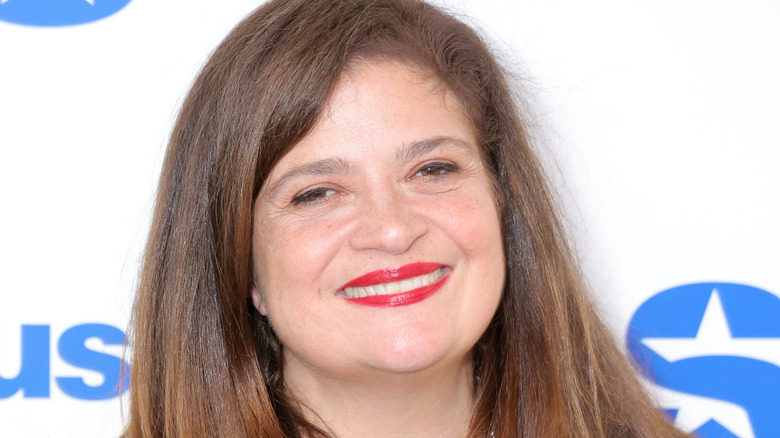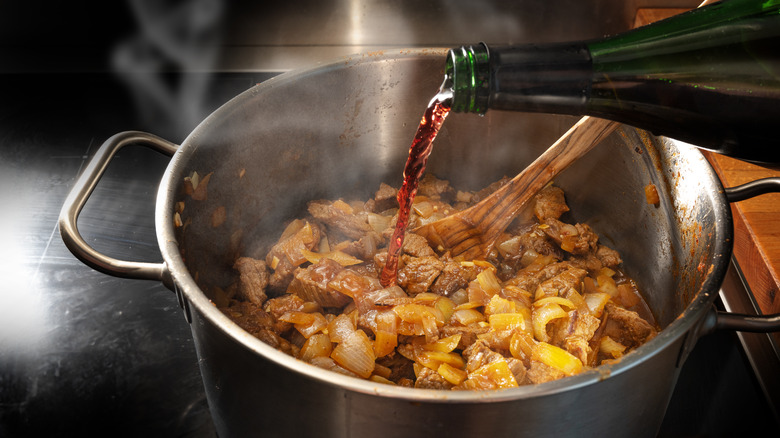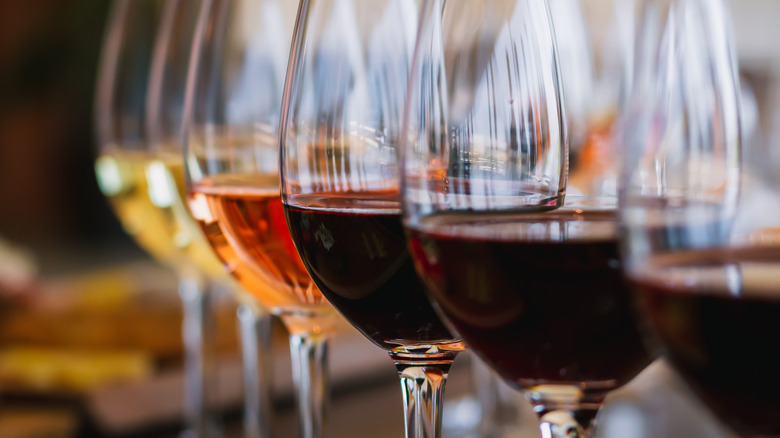The Cardinal Mistake Of Cooking With Wine According To Alex Guarnaschelli
Alex Guarnaschelli knows good food. The Iron Chef, Food Network star, and cookbook author certainly knows her way around the kitchen, and she has some pretty keen advice to share for home cooks looking to improve their sauteing skills and braising bonafides. However, it seems Guarnaschelli's advice also extends to wine. In an interview with Food & Wine, the chef spilled some of her opinions on wine as both a drink and an essential ingredient in cooking.
According to Guarnaschelli, the worst mistake a home chef (or any chef) can make is not letting the alcohol cook out of your wine before adding other liquids to your dish. For instance, if you're adding wine to a sauce or braise, you should add it to your aromatics in the pan and let the alcohol fully cook before adding in a stock or tomato sauce. Guarnaschelli notes that if you don't fully allow your wine to cook, "there will be that uncooked wine flavor." This can cause your dish to take on an unpleasant, slightly bitter taste that can throw off the flavor profile of whatever you are cooking, and that's no good. Of course, this is just the beginning of Guarnaschelli's wine knowledge, and there are a few other things you'll want to consider when cooking with wine.
Other common mistakes when cooking with wine
Of course, undercooking your wine isn't the only misstep Alex Guarnaschelli warns against. For one, you should be careful when deciding which wine to add to your dish. You may be tempted to use an expensive bottle in your cooking — after all, you'll want to bring only the best flavors to your dish. However, this might not be the best choice. When cooking with wine, Guarnaschelli notes that "so many of the most subtle flavors cook off." So, adding in a complex and expensive wine to your pot roast or chicken marsala might be a pointless endeavor. For more expensive wines, it's probably best to pour it into a glass for sipping, rather than a pan for stirring.
Another common mistake when cooking with wine is adding too much of it. Too much wine can be overwhelming in a dish, shifting the balance and creating an overly acidic, wine-centered taste. Remember, what you're looking for is balance in all ingredients, not just a focus on one. To correct this mistake, Guarnaschelli suggests adding in a fat such as butter or olive oil, which can tamper down the wine. She also suggests adding pureed onions or apples (for desserts) to "mellow the wine flavor." These tips can help you cook with wine, and without fear. After all, cooking is a balancing act, and mistakes can almost always be counteracted.
What wine adds to your dish
It's important to note, however, that even with these potential kitchen blunders, wine still makes for a fantastic ingredient in many dishes. So what, exactly, does wine add to food? According to Alex Guarnaschelli, wine is "great for adding acidity to rich dishes." This means it's great for perking up dishes that might otherwise be too dense, rich, or buttery. Essentially, wine should be added to bring brightness to a dish, and the wine you choose should complement your recipe's other ingredients. Red wines, for example, have a complexity that best suits beef roasts. White wine is milder and often has crisp citrus notes, making it a better choice for lighter seafood-based dishes.
You can also work in reverse and use your wine to build a recipe, letting its flavor profile inspire your cooking adventures. As Guarnaschelli notes: "Wine of any kind produces personal reactions and taste sensations." So, you should use those reactions and sensations to guide your cooking. Doing so might just be the key to mastering the art of cooking with wine. And even if you make a few blunders, you'll probably have enough left in your bottle to have a consolatory glass of red or white, and that's never a bad thing.


